Your Next Trip: Morocco
By Susan Farewell
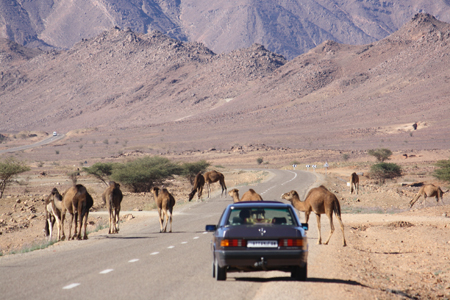
I will never forget the feeling I had when traveling around Morocco with my teenage daughter. Each night, we’d fall asleep wondering what the next day would bring. And each day was like opening another present. We were always surprised and completely delighted by what we found.
Morocco is truly exotic compared to so many destinations. Whether it’s the food, the mosques, the markets, the scenery, the music...no one I know has ever come back disappointed.
Here are just some of the reasons Morocco never fails to enchant.
What would you like in your tajine?
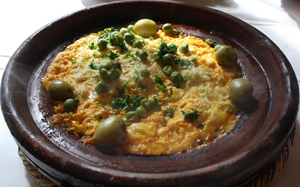
You won’t be in Morocco more than six hours before you’ve had a meal served in a tajine. Moroccans cook almost all of their food in these traditional earthenware pots which have tall, cone-shaped lids. Typical tajine dishes include chicken, fish or meat along with vegetables, potatoes and sweet spices. They also can be filled with fragrant Moroccan stews or a variety of omelets. Often they are accompanied by couscous, the savory taste of which I’ve never been able to replicate back home.
Medinas: Ancient Malls Behind Walls
Spend one hour walking around a Moroccan medina and you will find yourself utterly speechless and probably lost. These walled old towns, teeming with people of all ages, are a distillation of Moroccan life with all sorts of aromas, eye-popping colors and mosaics, and an ever-changing symphony of sounds. Often car-free, they are labyrinths of narrow streets chock-a-block with shops and food stalls and home to mosques, museums, private residences, even universities. You’ll find medinas in the Imperial cities of Marrakech, Fes, Meknes, Casablanca, Rabat, Agadir and Essaouiria.
Sweet Desert Dreams
One minute you’re bouncing around in a four-by-four, the next, silently gliding through salmon-colored dunes atop a dromedary camel. Your destination for the night: a bivouac, consisting of elaborate tents complete with rugs, private bathrooms and showers, and unexpectedly comfortable beds. You’ll enjoy a delicious three-course meal as you’re entertained by Moroccan drums. Later, the silence of the desert will help you settle in for a beautiful sleep.
The next morning starts early, as you mount your camel for a sunrise excursion, followed by a hot breakfast. All said and done, you’ll wonder if the whole experience was a dream.
At Home with a Berber Family
One of the most rewarding experiences to be had in this country is visiting a Berber village and spending time with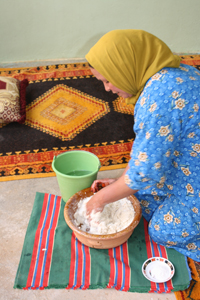 a local family. The original inhabitants of Morocco, Berbers raise livestock and cultivate their vegetable and spice gardens and henna fields while keeping many hand-made art forms alive. You can learn how to make traditional bread and a tajine dish, and have your hands and feet painted with henna or your hair adorned with saffron by a local village artist. a local family. The original inhabitants of Morocco, Berbers raise livestock and cultivate their vegetable and spice gardens and henna fields while keeping many hand-made art forms alive. You can learn how to make traditional bread and a tajine dish, and have your hands and feet painted with henna or your hair adorned with saffron by a local village artist.
Worth Making the Trip For: Rugs
We weren’t planning to get my daughter a rug for her future college dorm room, but it became a mission while we were there. We zeroed in on the Berber designed rugs, also known as kilims. Hand-woven with high-quality wool, they feature intricate geometric designs and intense colors. No two are alike. And then there are the urban rugs, which are more finely woven with higher knot counts, generally with price tags to match.
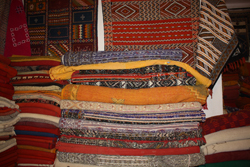
When in Morocco, go to a rug shop at a souk (which is a marketplace or bazaar in any of the cities or towns) and you will learn the ABCs of the country’s rugs over glasses of sweet mint tea. But before you even leave home, take measurements of every room in your house. You will inevitably kick yourself if you don’t. The prices are excellent and at the very least, grab one for your powder room.
What a Scene!
Once a significant stop for caravans traveling between the Sahara and Marrakech, Ait Be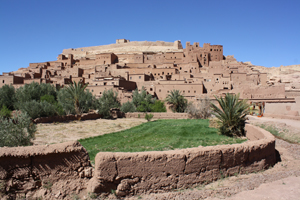 nhaddou is a fortified city (or Kasbah) that brought Hollywood to this part of the world. Back in the early 1960s, it was used as a location for Lawrence of Arabia. Later Orson Welles used it for Sodom and Gomorrah and then Jesus of Nazareth. Today, nearby Ouarzazate and the whole area is a magnet for directors following in their footsteps to capture the magnificent scenery in their films and television shows. Fortunately, Ait Benhaddou, is being restored under UNESCO auspices. nhaddou is a fortified city (or Kasbah) that brought Hollywood to this part of the world. Back in the early 1960s, it was used as a location for Lawrence of Arabia. Later Orson Welles used it for Sodom and Gomorrah and then Jesus of Nazareth. Today, nearby Ouarzazate and the whole area is a magnet for directors following in their footsteps to capture the magnificent scenery in their films and television shows. Fortunately, Ait Benhaddou, is being restored under UNESCO auspices.
Calling it a Night in a Riad
From the outside, riads look very unassuming. These traditional Moroccan houses-turned-small hotels, are ge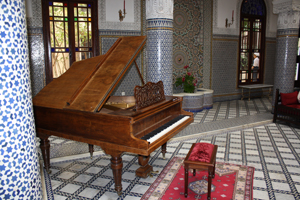 nerally tucked away in the medinas and tend to blend in with the surrounding exterior clay or mud-brick walls, never calling attention to themselves. Step inside, however, and you are transported into a whole different world. nerally tucked away in the medinas and tend to blend in with the surrounding exterior clay or mud-brick walls, never calling attention to themselves. Step inside, however, and you are transported into a whole different world.
Often very elaborate with mosaics and Arabian architecture, riads always have an interior courtyard or garden with orange or lemon trees and some sort of water feature (be it a fountain or a small pool with water lilies and lotus flowers).
You can book a room or an entire riad in the cities and some of the s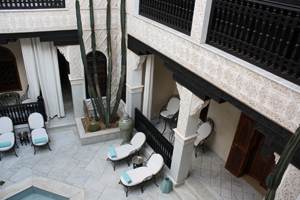 maller seaside towns. maller seaside towns.
They range from simple and comfortable to full five-star comfort and service. Pictured here is the central atrium of the Riad Fes in Fes (above) and one of the interior courtyards at La Sultana (left), which is a collection of five riads in Marrakech.
Some of the newer hotels pride themselves on creating riad-like accommodations. Most extravagant of them all is the Royal Mansour, which offers exqusite one-, two- and three-bedroom riads. Created at the behest of the King of Morocco, this magnificent property was designed to represent the classic forms of the traditional medina.
It is every inch a conversation piece…just like the country itself.
|

